This post may contain affiliate links. Please read our disclosure policy.
How to use rice paper wrappers might seem daunting at first, but this guide will make you a pro in no time! From selecting the right type to mastering the wrapping technique, we cover it all.
You’ll also learn various ways to prepare and enjoy rice paper in your meals. Whether you’re making fresh spring rolls or crispy rice paper dumplings, you’ll find helpful tips and delicious recipes to ensure success every time.
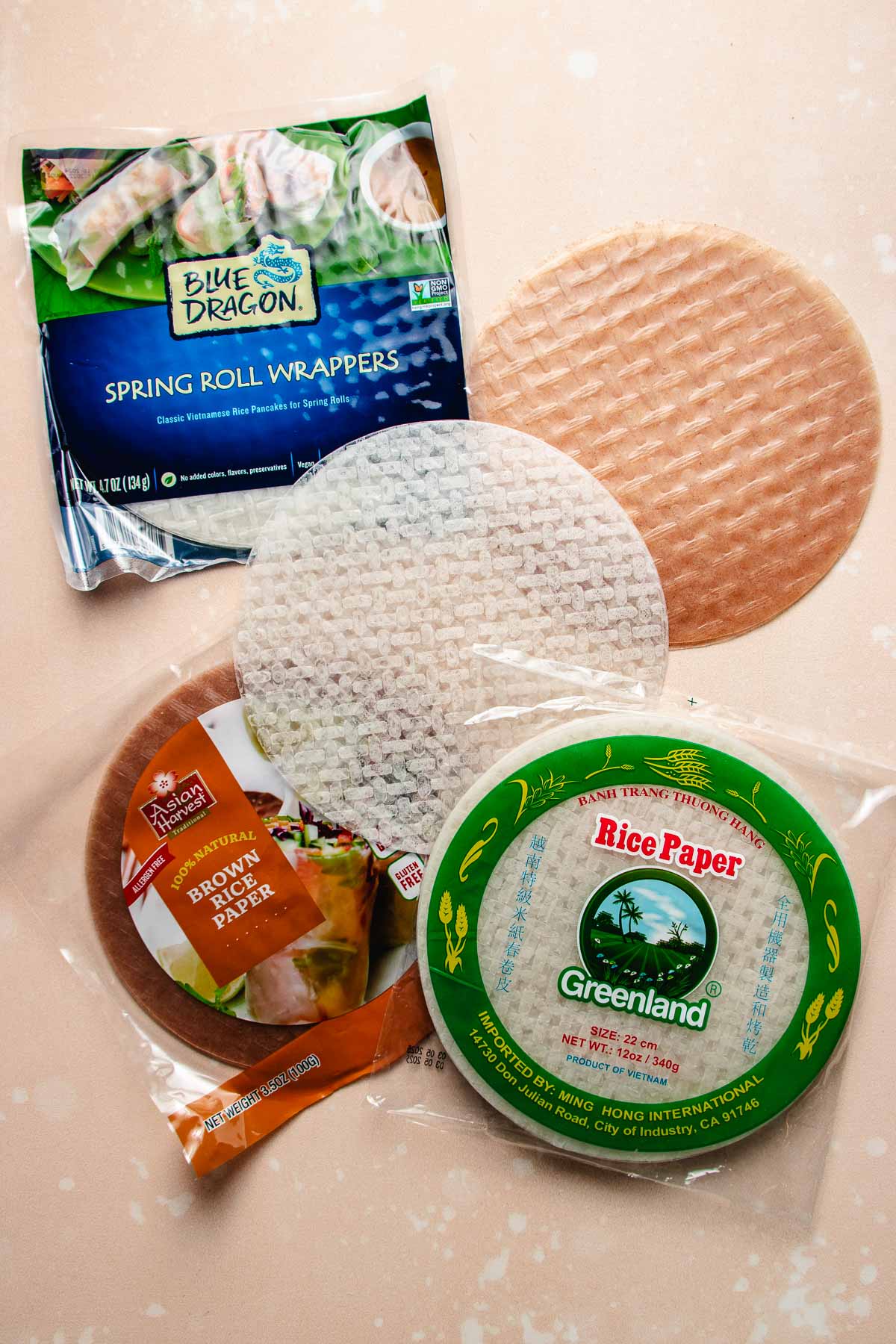
Table of Contents
What are rice paper wrappers
Rice paper wrappers are thin, see-through sheets made from a blend of rice flour, water, and sometimes a bit of starch and salt. In Vietnamese kitchens, they’re called bánh tráng.
These wrappers are crafted by mixing rice flour with water to form a dough. This dough is then steamed to cook the starch, spread out thinly, and dried into delicate, translucent sheets that resemble paper. You can find them made from either brown or white rice.
Some rice paper takes a bit longer to soften because it only contains rice flour and water. However, versions with added starch are quicker to handle as they soften faster with just a short dip in water.
Rice wrappers are a great gluten-free option—just make sure to check the labels to confirm they are processed in a gluten-free facility.
They have a mild taste, which means they easily absorb the flavors of whatever you fill them with. Once moistened, they become flexible, perfect for wrapping goodies or slicing into noodles.
Where to buy rice paper
You can find rice paper wrappers in the Asian food aisle of many big grocery stores or you can buy them online. Some popular brands to look for include Three Ladies and Three Crabs.
If you visit an Asian market, you’ll see an even bigger variety of rice papers. They might be sold as spring roll wrappers, summer roll wrappers, or simply as rice papers. These can be made from either white rice or brown rice.
Stores like Whole Foods also have a good selection of different brands of rice paper. These can be round, often about 8.5 inches (21.5 cm) in diameter, or square, and they come in various thicknesses. Once you open a package, keep it in a cool, dry place inside a sealed bag to prevent them from getting moist.
TIP: When choosing rice paper, try to pick one that lists starch (like tapioca) early in the ingredient list. Rice paper with starch is tougher and less prone to tearing, making it easier to work with.
How to use rice paper
Getting started with rice paper might seem tricky, but it’s really simple once you know the steps. Here’s how you can master the art of using rice paper for perfect rolls every time.
- Set up:
- Water: Use a shallow bowl wide enough to fit the rice paper easily. Fill it with room temperature water to soften the wrappers.
- Non-stick Surface: Lay a non-stick cookie sheet or a large chopping board on your counter. This helps prevent the rice paper wraps from sticking as you roll.
- Optional New tools: Use a special “rice paper tray” designed to prevent sticking and a “rice paper water bowl” to help dipping and softening the sheets.
- Soften/rehydrate:
- Dip by rotating one sheet at a time. Dip one rice sheet at a time into the water. Slide it halfway into the water then rotate it quickly. You only need about 5-7 seconds for each sheet.
- Dip for 5- 7 seconds. After dipping, the paper should still feel a bit firm. It will continue to soften on your work surface, getting ready for rolling.
- Wrap/roll:
- Place the rice paper smooth side down. It will take a few more seconds to become flexible enough for rolling.
- Put about 2 heaping tablespoons of your chosen filling on the lower third of the sheet. Carefully roll it up tightly, folding in the sides as you go. For extra durability, use a second sheet of rice paper as reinforcement.
- Dip with sauce:
- Enjoy your rice paper rolls with a variety of delicious sauces. Some great options include Vietnamese dipping sauce (nuoc cham), sweet and tart Egg roll sauce, gluten-free hoisin sauce, authentic Thai peanut sauce, and Paleo peanut sauce. These sauces add a fantastic flavor boost to your rolls!
How to wrap rice paper rolls
- Soften the Paper: Submerge a rice paper sheet in the water for about 5-7 seconds. It should still feel quite firm when you remove it, but don’t worry—it will continue to soften as it lays out.
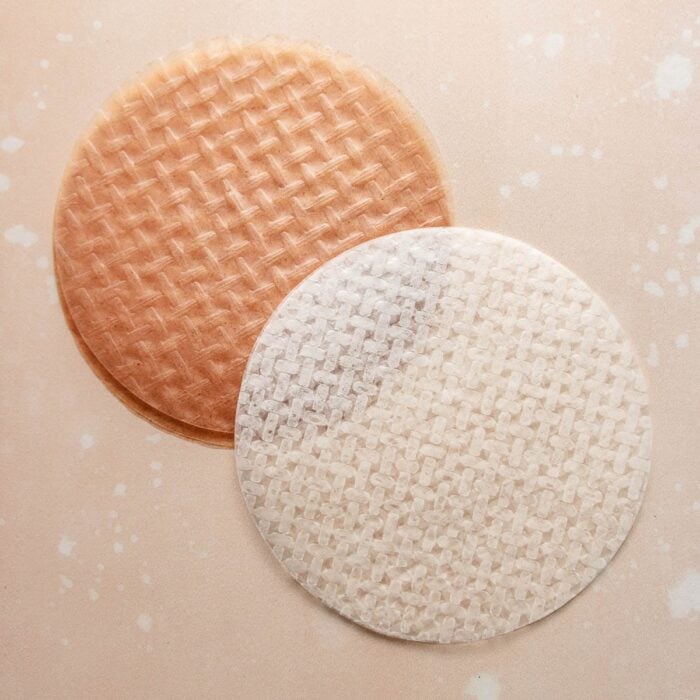
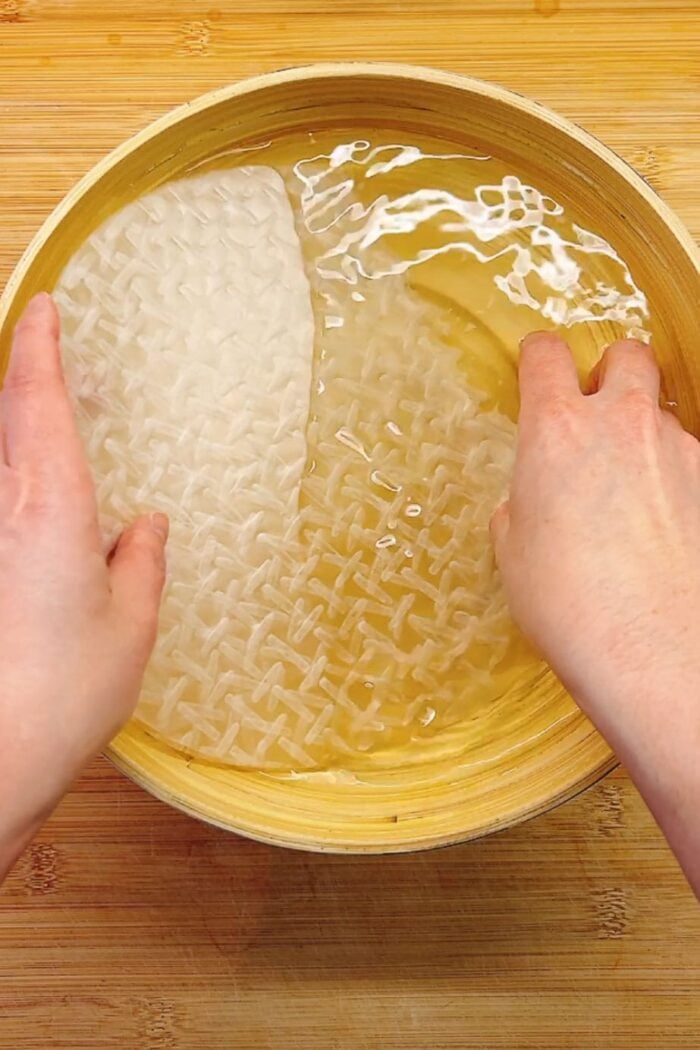
- Prepare to Wrap: Place the rice paper rough side up (smooth side down) on the non-stick cookie sheet. This positioning helps when it’s time to roll.
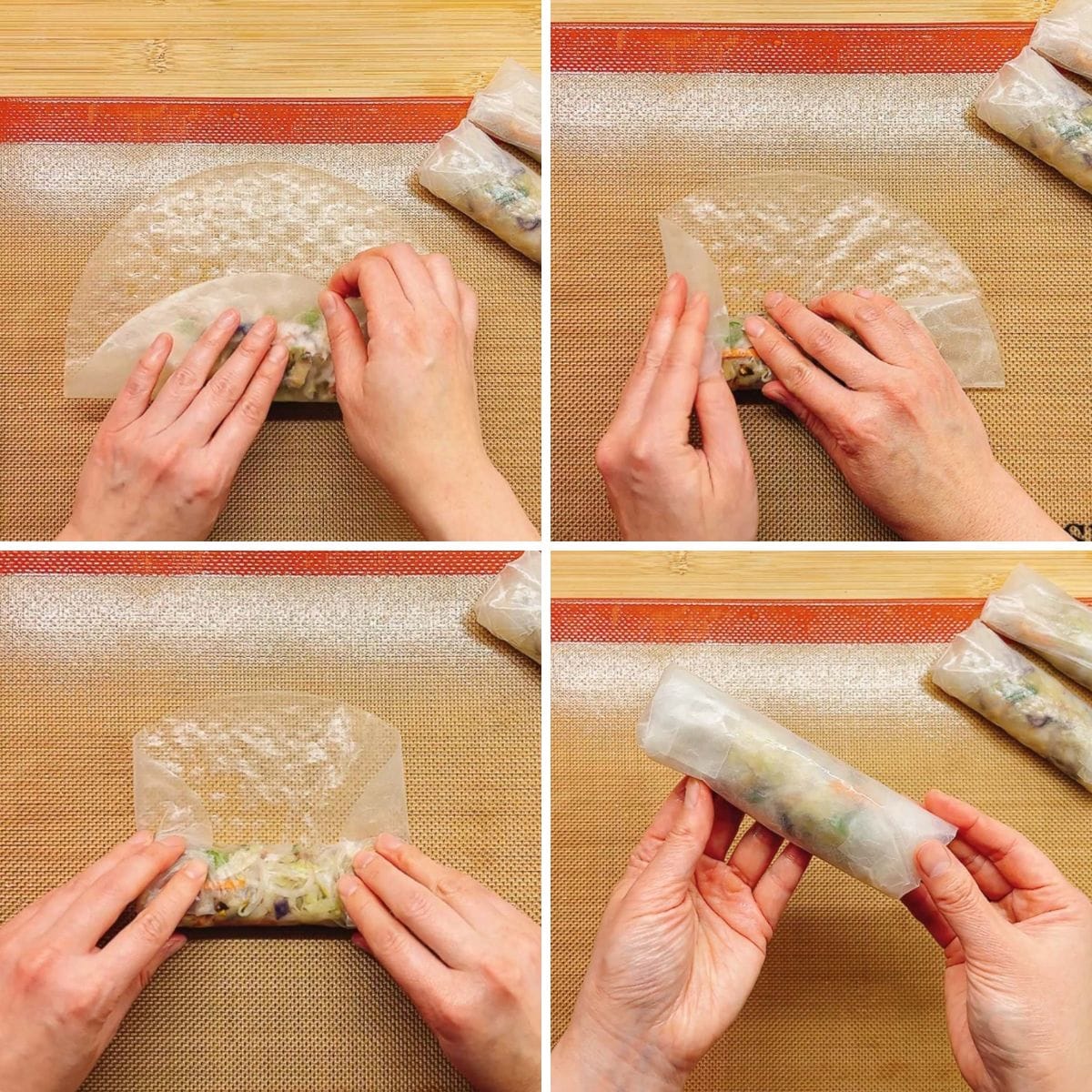
- Add the Filling: Scoop 2 heaping tablespoons of your filling onto the lower third of the rice paper, near the center.
- Roll It Up: Gently but firmly roll the rice paper away from you, encasing the filling. Push the filling in slightly as you go to keep it compact. Fold the sides of the rice paper toward the center over the filling to help hold everything together.
- Seal the Roll: Continue rolling until the entire sheet is wrapped around the filling. To reduce the chance of tearing and to ensure a sturdy roll, you can wrap each roll with 2 rice sheets.
- Arrange the Rolls: Place the rolled rice paper on the plate or sheet pan with a bit of space between each to prevent them from sticking together.
Troubleshooting common rice paper issue
Tearing
- If your rice paper rips during wrapping, don’t worry! Simply use two sheets overlapped together for double strength. This helps prevent tears and makes wrapping easier.
Too soft/too wet
- It’s easy to soak the rice papers a bit too long, especially if you’re just starting out. If the paper becomes too soft and sticky, it can be tough to work with.
- If this happens, just discard the soggy sheet and start fresh with a new one. Remember, a quick dip in water for about 5-7 seconds is usually just right.
Too hard (not pliable enough to fold)
- If the rice paper isn’t softening enough to fold without breaking, it might need a bit longer in the water. A good rule of thumb is to dip each sheet for 5 to 7 seconds in room temperature water.
- It should still feel firm when removed; give it a few seconds to a minute to absorb moisture and become pliable.
Sticking to the surface
To keep rice paper from sticking to your work area, you have a few options:
- Lay down a large non-stick cookie sheet,
- Lightly moisten the work surface, or
- Use a special “rice paper tray” designed to prevent sticking. This tray has holes that allow water to drain, ensuring your rice papers don’t stick as you roll.
How to store rice paper
Dry and unused rice wrappers:
Keep your unused rice paper wrappers in large ziplock bags to protect them from moisture. Then, store these bags in a cool and dry cupboard. There’s no need to refrigerate them, as they stay fresh at room temperature.
Storing softened rice paper sheets: (Fresh summer rolls)
Fresh summer rolls taste best when eaten on the same day they are made. However, if you need to prepare them a few hours in advance, here’s how to keep them fresh:
- Place the rolls separately on a large plate to avoid sticking.
- Cover the rolls with a lightly moistened, clean tea towel. Then, loosely wrap the entire plate with plastic wrap. This setup helps maintain the right moisture level to keep the rolls soft and delicious.
What not to do:
- It’s best not to store moistened rice paper wraps in the fridge. If refrigerated, they tend to become hard and dry. Always aim to enjoy them fresh for the best taste and texture.
Different ways of using rice paper sheets
Rice paper is versatile and can be used in many delicious ways. Here’s how you can enjoy it:
- Soft wraps: The simplest method is to soften the rice paper in water and use it as is. This is how you make Vietnamese fresh spring rolls, also known as soft spring rolls—no cooking required, just enjoy the fresh flavors! My Shrimp Summer Rolls are an example.
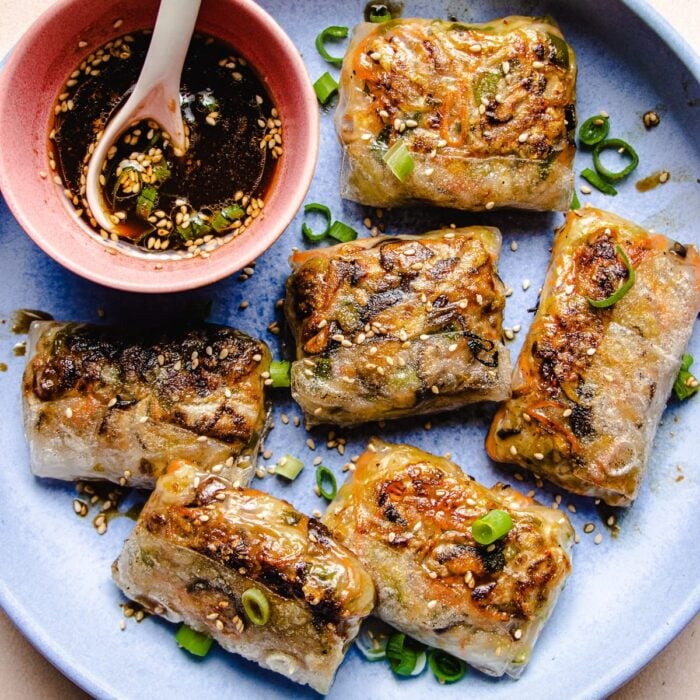
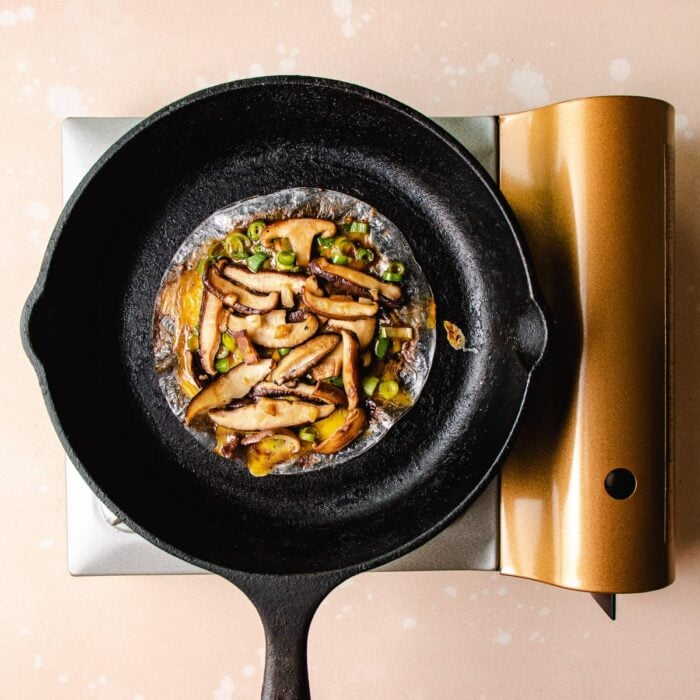
- Pan fry: For a healthier alternative to deep-frying, try pan-frying your rice paper rolls. This method uses less oil and achieves a crispy texture that’s really satisfying. It won’t be as crispy as deep-frying, but it’s still very tasty.
- Pan grill: When you’re looking for a crispy base for your toppings, pan grilling is perfect. Just dry roast the rice wrapper until it becomes opaque and crispy. Check out my Vietnamese rice paper pizza recipe for an example of how to do this.
- Air fry or Bake: Air frying or baking rice paper rolls is another healthier option that uses minimal oil. Between the two, air frying usually gives a better result, making the rolls nicely crispy.
- Deep fry: For the crispiest, most delicious texture, deep frying is the way to go. This method provides a quick, high-temperature cook that leaves the rice paper shatteringly crisp.
Filling ideas
When preparing fillings for your rice paper rolls, slice them into thin strips to fit neatly within the rolls. Avoid using hard or rigid ingredients as they might puncture the delicate sheets. Here are some tasty filling ideas:
- Try filling your rolls with flavorful thinly sliced Vietnamese lemongrass pork, or go for a bulgogi beef bowl mix.
- Kalbi short ribs are another great option that pairs wonderfully with the subtle taste of rice paper.
- For something lighter, Vietnamese bun rice noodles make a perfect filling that’s both refreshing and satisfying.
- You can also wrap cooked shrimp, chicken, shredded carrots, cabbage, cucumber, tofu, or bean sprouts to make your own lunch salad roll.
Helpful tips
- Select rice paper sheets with tapioca starch as the first ingredient for best durability and easier handling, as they are less likely to tear during wrapping.
- Check the Water Temperature: Always use room temperature water to soften the rice paper sheet. Too hot or too cold can affect the texture and make the sheets either too brittle or too sticky.
- Dipping Time is Key: Dip the rice paper into the water for no longer than 5-7 seconds. It’s important to keep the dipping brief to avoid oversoftening, which makes the sheets difficult to work with.
- Work Quickly: Once soaked, the rice paper will continue to soften as you prepare to roll. Work efficiently to add your fillings and roll the sheets before they become too limp.
- Prevent Sticking: Use a non-stick surface such as a large silicone baking mat or a non-stick cookie sheet when wrapping your rolls. This helps keep everything clean and intact.
- Double Up If Needed: If you’re worried about tearing, don’t hesitate to use two sheets per roll for extra strength and durability.
- Choose the Right Fillings: Opt for fillings that are not too hard or sharp to prevent tearing the wrappers. Soft, malleable fillings like cooked noodles, soft vegetables, and tender meats work best.
- Keep Rolls Separate: After rolling, place each finished roll on a plate without letting them touch each other. This prevents them from sticking together and tearing when you pull them apart.
- Cover to Keep Fresh: If not serving immediately, cover the rolls with a lightly moistened paper towel and then wrap in plastic wrap. This keeps them moist and fresh until you’re ready to serve.
- Use Proper Storage Techniques: Store unused dry rice paper in a ziplock bag in a cool, dry place. For leftovers, avoid refrigeration as it dries out the rolls—instead, consume them within a few hours after preparation.
FAQs
Dip rice paper in room temperature water for about 5-7 seconds. It should still feel firm when removed and will continue to soften as you prepare to fill and roll.
Use the rough side of the rice paper facing up when preparing your rolls. This side is better for absorbing moisture and helps the fillings stick more easily as you roll.
Soak rice paper in room temperature water. Hot or cold water can affect the texture, making the paper too soft or brittle, which complicates handling and rolling.
No, you don’t have to cook rice paper wrappers. They are used as-is after briefly soaking in water to soften. They can also be fried or baked for a crispy texture if desired.
Rice paper recipe ideas
Now you’ve learned how to use rice paper wrappers. Here are some recipe ideas to get you started, each one offering a unique and tasty twist on traditional favorites:
- Rice Paper Dumplings: One of my most popular recipes on the blog. These mini crispy morsels are loaded with fresh veggies and crispy delicious!
- Rice paper chive dumplings: These freezer friendly crispy dumplings come with a vegetarian filling. Fun to make and absolutely delicious!
- Rice Paper Egg Rolls: Crispy on the outside, with a savory, juicy filling – a healthier vegan twist on the traditional deep-fried favorite.
- Vietnamese Pizza: A creative, crispy base topped with vibrant flavors like shiitake mushrooms, and fresh herbs, all cooked to golden perfection.
- Rice Paper Noodles: Slice your softened rice papers into noodle-like strips for a gluten-free alternative in soups and salads.
- Gluten free wonton soup: A novel take on a classic dish, using rice paper for a delicate, gluten-free wonton that’s perfect for soups or frying.

How to use rice paper
Ingredients
- Rice paper sheets, about 8.5 inches (21.5 cm) in diameter
- 1 piece A large bowl, for dipping
- 1 piece A large chopping board
- 1 piece A nonstick cookie sheet
New helpful tools (optional):
- 1 piece Rice paper tray
- 1 piece Rice paper water bowl
Instructions
Set Up
- Prepare Water: Fill a shallow bowl with room temperature water. The bowl should be wide enough to fit the rice paper easily.
- Create a Non-stick Surface: Lay a non-stick cookie sheet or a large chopping board on your counter. This will help prevent the rice paper from sticking as you roll.
- Optional Tools: Consider using a special "rice paper tray" designed to prevent sticking and a rice paper water bowl for easier dipping and softening of the sheets.
Soften/Rehydrate
- Dip One Sheet at a Time: Take one rice paper sheet and dip it halfway into the water. Rotate it quickly to wet the entire sheet. You only need to dip it for about 5-7 seconds. The paper should still feel a bit firm when you take it out of the water. It will continue to soften on your work surface, getting ready for rolling.
Wrap/Roll
- Place the Rice Paper: Lay the rice paper smooth side down on your non-stick surface. The rice paper will continue to soften as you fill it with ingredients and as you roll.
- Add Filling: Place about 2 heaping tablespoons of your chosen filling on the lower third of the sheet.
- Roll It Up: Carefully roll the rice paper up tightly, folding in the sides as you go. For extra durability, you can use a second sheet of rice paper as reinforcement.
Dip with Sauce
- Enjoy: Serve your rice paper rolls with a variety of delicious sauces and enjoy!
Notes
- When selecting fillings for your rice paper rolls, take the length and thickness into considerations – the softer and the flatter the filling the better to avoid tearing the rice sheets.
- Slice the fillings into thin strips to fit neatly within the rolls. Avoid using hard or rigid ingredients as they might puncture the delicate sheets.
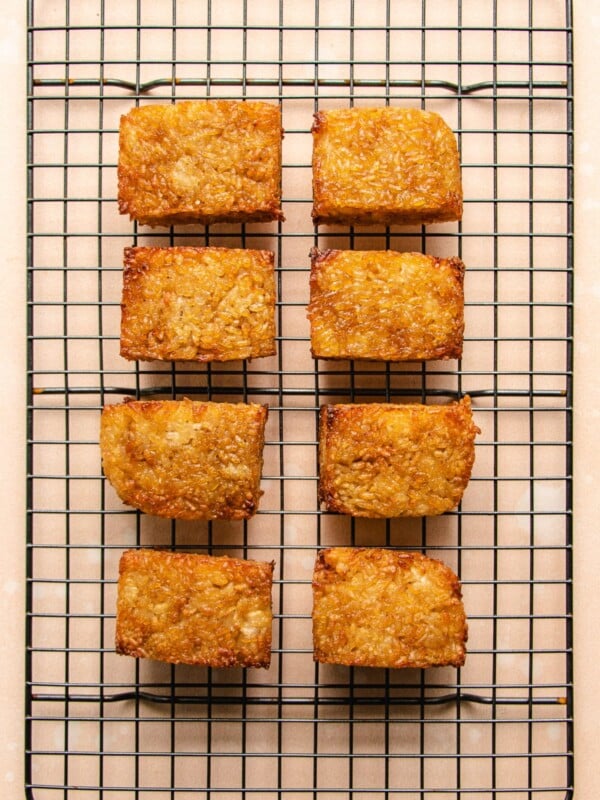
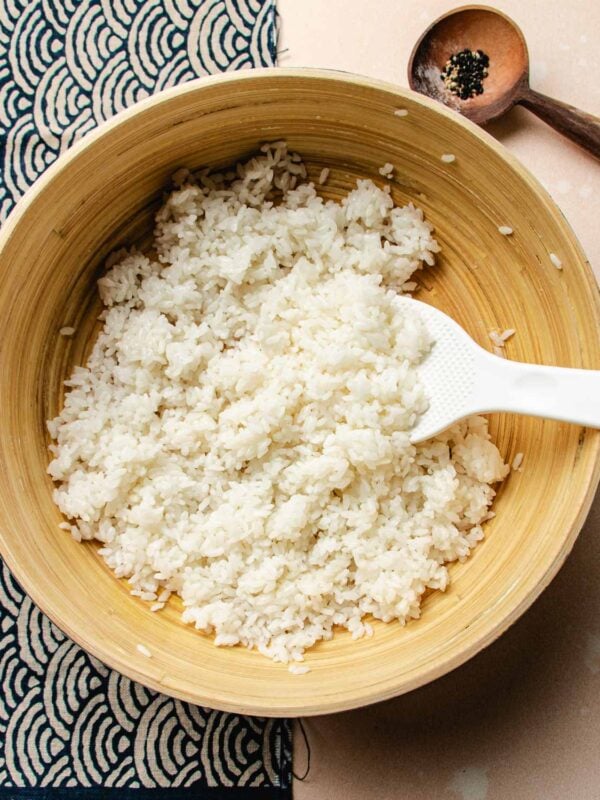

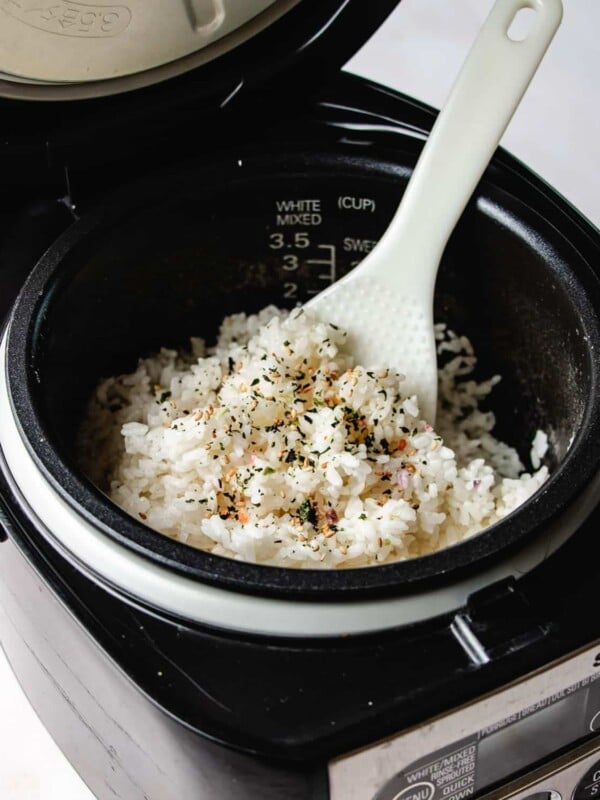









Thank you for the guide! Great for beginners like me. I always had issue with using rice papers – they turn soft and sticky very quickly and easy to tear apart. I followed the instructions and am getting a much better handle with the rice wrappers now. Next time, I’ll also get the dipping bowl and the tray. Thanks again!
Welcome!